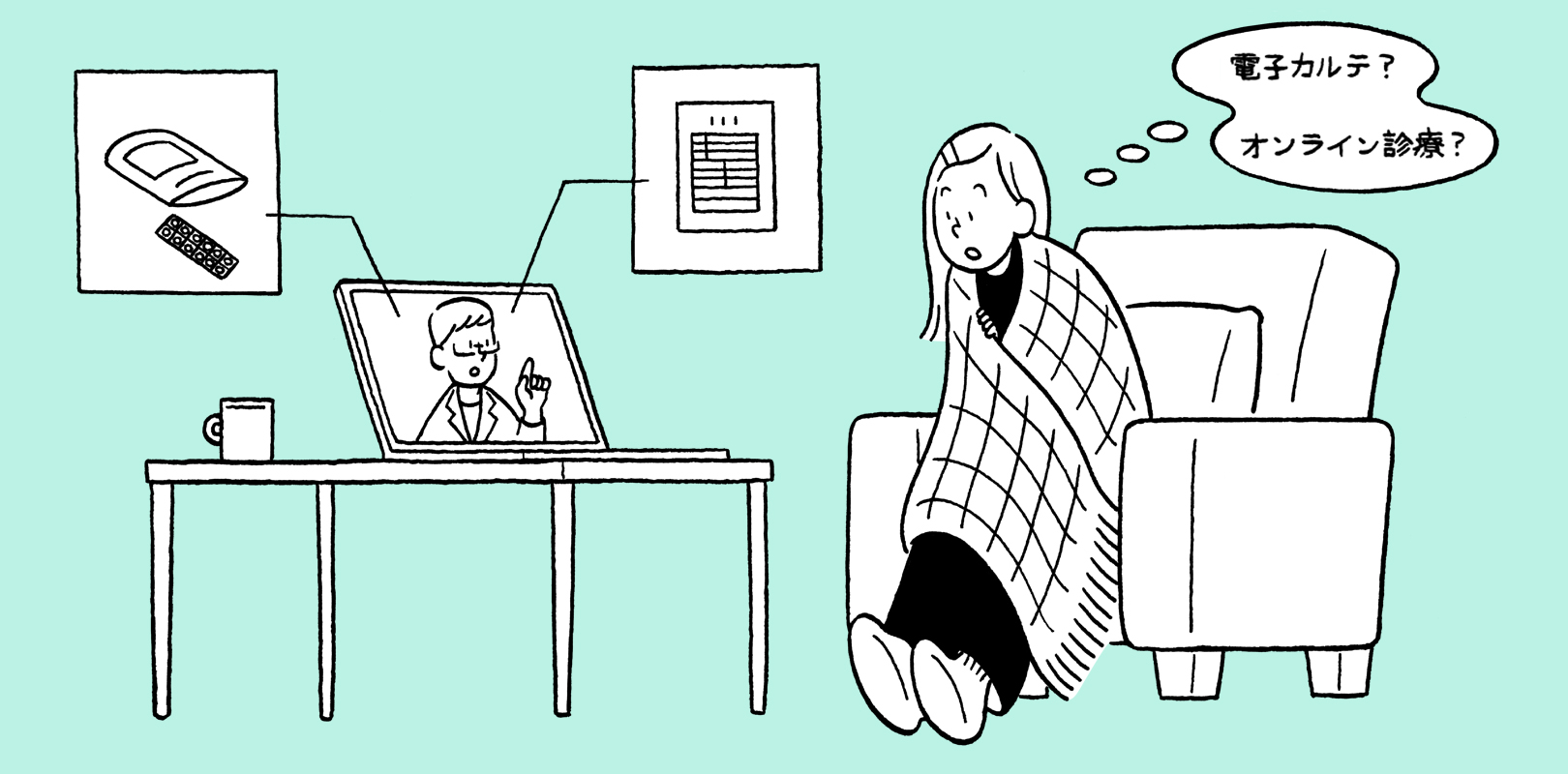- JP
- EN
Feb. 28, 2022 UP

The abbreviated term “DX,” which stands for “digital transformation,” has proliferated with the advancement and evolution of digital and IT technologies. While digital transformation (DX) is clearly related to digital technologies, what does this term actually mean? We look at the foundation of DX through the lens of the medical and healthcare industry, a familiar area with relevance to our everyday lives. Masaki Ishiguro, Section Manager for Sojitz’s Healthcare Department’s Business Development Section 3, answers 10 questions about DX.
Text_Kayo Yabushita (Original Japanese)
Photograph_Kaoru Yamada
Illustration_Saki Obata
Edit_Shota Kato (Original Japanese)
1. While the term DX is frequently used these days, what exactly does DX mean?
DX refers to the revolutionary transformation made possible through the application of IT technologies in business and daily life. We are seeing a global trend in which companies respond to the changing needs of customers and society with products, services, and business models that utilize data and digital technologies in new ways.
2. What is the difference between “DX” and “digitization”?
Digitization is the conversion of analog information to digital form. For example, an office that circulates printed hardcopy documents can increase work efficiency by converting these documents to digital files through digitization. Put simply, digitization raises productivity for existing work. In contrast, DX is a broader update that reimagines how existing work can be fundamentally improved through the application of digital technologies. In a logistics business, a DX update would go beyond raising efficiency through digitization for logistics processes, but also involve creating new delivery plans based on analytics provided by big data.

3. What are some successful DX projects currently attracting attention in Japan or overseas?
Personally, I was interested in watching the development of Try Group’s new online tutoring service, “Try It.” It’s a video tutoring service available on smartphone platforms for middle and high school students with lessons that can be watched anywhere at any time. Try Group leveraged its experience dispatching tutors for in-person lessons when adding new web-based lectures to its in-person classes. By adding additional options for students, Try Group now offers middle and high school students both in-person and online learning. This new online tutoring service helps to equalize opportunities for students by removing disparities based on geographic and economic factors. In the future, Try Group will likely analyze and make use of the insights gained from students’ online study data.
4. How does Japan compare to other countries when it comes to DX? Is Japan behind Europe and the U.S.?
I don’t believe that’s the case. While Uber is the quintessential example overseas of a service defined by its digital technologies, there are also DX businesses emerging in Japan like the Try Group, particularly in industries with a compatibility for digital technologies. Japan is expected to produce more DX businesses moving forward that utilize the advantages of on-site expertise.
5. One of the merits of DX is improved efficiency. That being said, are there any disadvantages or challenges associated with DX?
One of the big issues is ensuring that system feasibility aligns with actual operations. For example, in healthcare settings, electronic medical records are becoming increasingly common in Japan. However, these records can be difficult to integrate across systems without a standardized format for patients’ electronic medical records.
6. What DX trends can be seen on-site at medical facilities?
Telemedicine is on the rise. In the past, one had to take the time to visit a medical facility when ill to be examined and then return home. Going forward, it will be possible to be seen by doctors remotely in cases when urgent, in-person care is not required. However, after a doctor’s appointment, the next step is treatment. One issue some countries face with telemedicine is how to deliver prescription medications to a patient’s home. The real and the digital must be integrated effectively otherwise users can face difficulties when using the system.

7. What is needed to facilitate DX?
First, digitization must be implemented to serve as a foundation for DX. Considering the fact that DX involves broader updates to existing work through the application of digital technologies, digitization is an important prerequisite. It is also essential for companies and systems to be integrated and interoperable to serve as a foundation for DX.
None of us are immune to the sudden onset of illness. When we think about DX and the medical and healthcare fields, we recognize the necessity of having both online and offline care. This concept of integrating online and offline services is called “online merge offline (OMO).” One mainstream idea in DX now is the need to expand the reach of services by integrating both the online and offline.
8. How can medical institutions and users benefit from the realization of DX?
In Japan, health care has always been focused on hospitals, where medical expertise and equipment is concentrated. If you fall ill, you visit the hospital, where there are doctors, nurses, and the necessary medical equipment and devices to examine, treat, and then provide you with medication. However, DX decentralizes this care, providing users with additional options such as online consultations to prevent disease, online telehealth visits as required, and follow-up appointments through prognosis as part of a streamlined service. Telemedicine can be beneficial for those living in remote areas and allows home-bound parents and caregivers to seek medical advice from doctors. Going forward, we will see a shift from centralized care at hospitals to a more individualized patient care model.

9. How do you think DX will evolve in the midst of the Covid-19 pandemic?
Due to the impact of the pandemic, medical televisits have become a common experience for the average patient overseas. We see that telemedicine naturally cannot cover all conditions, and that there are situations that call for face-to-face care. In the future, I’m sure there will be demand for a user-centered OMO model that optimizes both the digital and the real. An OMO approach in health care can be widely applied, and I think we will retain both digital and in-person options as this integrated business model continues to develop.

10. What future awaits us with DX?
At Sojitz, we are currently engaged in a number of medical DX projects through investment in healthcare companies both in Japan and overseas. If you look at the global healthcare landscape, you will notice clinic chains increasing across Asia. This might sound like an extreme comparison, but medical clinic chains may become as easily accessible and widespread as Japanese convenience stores. With growing health awareness around the world and high interest in preventative health measures, Sojitz aims to expand clinic chains through a multifaceted approach as well as offer new services through DX. I think we can look forward to some exciting future opportunities to come from the medical industry.
As a general trading company, we are not a hospital or health care provider, but we have traditionally fulfilled our mission of providing essential goods and services where there is a need. We will leverage the experience and networks we have built over more than 140 years and apply this experience to the medical world. We will help to connect medical institutions with companies that possess the needed DX technologies and services in order to build new services. Sojitz’s global network of connections puts the company in a unique position to contribute to the medical industry.
While many people may be intimidated by the term “DX,” a future of digital transformation is one of greater prosperity for all. Of course, Sojitz is not the only company taking on the DX initiatives, and there are many companies in a variety of industries implementing DX. If you look up DX in a field of interest, you might see that digital transformation is not such a foreign concept.

Note: Employee titles and affiliations reflect those at the time of the article’s publication.

Masaki Ishiguro
Ishiguro serves as Section Manager of Business Development Section 3 for Sojitz’s Healthcare Department. The Business Development Section is pursuing new developments in the Healthcare Department that hinge on keywords such as wellness and DX. Sojitz has acquired stake in a number of healthcare startups, and Ishiguro and his team manage these partnerships as the Healthcare Department.